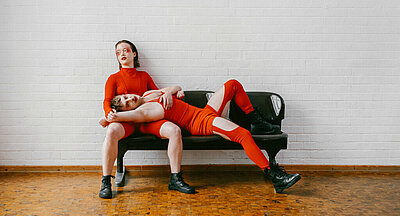Nurture the Artists, and They will Nurture the Art
Centered around artistic practices: Kareth Schaffer on her experiences with the Tanzpraxis scholarship.

In 2020, the long-term scholarships Tanzpraxis (Dance Practice) were issued in Berlin in a pilot programme developed during the participative process of Runder Tisch Tanz in 2018. While the funding system in Berlin has so far been organized primarily on a project basis, the Tanz praxis scholarships aim to support the respective artistic practices and not single projects, in order to enable continuous and sustainable artistic work. In the following text, Kareth Schaffer tells how she used the money and time from the 1.5 year Tanzpraxis grant.
Text: Kareth Schaffer
Dancer and choreographer
My story with the Tanzpraxis scholarships did not start in July 2020, when I was one of 41 Berlin dance artists to receive this longterm stipend in a pilot programme of the Berlin Senate. Instead, it started in 2018 at a meeting called by the participative process Runder Tisch Tanz (Round Table Dance) on the topic of “Money and more.” The meeting was taking place at radialsystem, and was open to anyone who identified as a professional in dance. It was packed. While the subject of funding was being hotly debated, someone (very likely Gabi Beier of ada Studio) said: “I don’t want arts-centric funding for dance, I want artist-centric funding for dance.”
What artist-centric funding means
At the time, I did not grasp the full meaning of this sentence, and what it would come to mean to me. In retrospect this is astonishing: Dance artists are very much the outcome of their own labour. This vulnerable durable body of mine, this body that can do so many things and fails to do so many more, is the result of work that I have been doing for years. Late night pacing, note taking, and muttering to myself. The warmups, weekend stretches, the dance classes (that I paid for). The search for just the right sound, just the right chiropractor, just the right imagery that will unlock the score I’m look ing for, the vibrance that is still missing, the concept that remains elusive. The coffee dates with potential collaborators. Literally all of the work that occurs outside the confines of rehearsals leading to a premiere. This work must continue, whether performance dates are on the horizon – or not.
One irony of receiving Tanzpraxis during the pandemic was, of course, that suddenly everybody realized that you need artists in order to have the art – on a live stream or occurring in some still unknown future. Germany disbursed billions of euros at federal state, and municipal levels to pre vent a mass extinction of the cultural scene, and a great number of those millions were individual scholarships, e.g. in NEUSTART KULTUR pro grammes such as #TakeThat of the Fonds Darstellende Künste, DIS-TANZEN of the Dachverband Tanz Deutschland, or the scholarships issued by the Gesellschaft zur Verwertung von Leistungsschutz rechten (GVL). I will choose to believe that some one was paying attention to the Tanzpraxis proposal from 2018 and was ready when shit really hit the fan... #schnellundunbuerokratisch.
But let’s get back to the words uttered at the Runder Tisch Tanz meeting. Artist-centric fund ing means to me: Nurture the artists, and they will nurture the art. I am not sure how much I had previously applied this to myself, although it is obvious when making art with other people. So much of my work as a choreographer has relied on the maxim that if you nurture people, or even nurture the environment through which they can take care of themselves, the dance will come. Cared for bodies become braver, more curious, more empowered. We are both instruments and players. Our practice must continue.
Changing the paradigm
Tanzpraxis meant a 1.000 euros extra per month, directly to me, no strings attached. What did I do with my Tanzpraxis scholarship? For starters, I said no – I turned down projects that were not convenient to me. Everyone knows what kind of projects these are: The projects that have you on a plane at 5 a.m. the day after your last show. The projects that you would like to do if there was more time and more fun. The projects that you accept because there are more days left in the month than money in your bank account.
Next, I rented a studio to use in the down times, the times I was not in full time rehearsals. I lay on the floor a lot. I invited friends.
I listened to old playlists on iTunes and made up steps to counts of 8.
I attended to a lot of the physical skills that I have often neglected (Balinese dance) and maintained some new ones I would need soon (jump ing rope).
I joined an Anatomy in Motion seminar online and educated myself.
I got physical therapy from a highly recommended person who unfortunately only accepts private insurance. My knee – finally – became unfucked in 2021.
I bought, and even read, so. many. books. I gave studio time to colleagues. I did not worry about money. I built up a buffer on my savings account. I did not worry about money, cancelled shows,
postponed shows, sudden transformations into live streams and online premieres. I luxuriated in the ability to work as I chose. I claim this word, luxuriate, for all the dance artists who still deserve this possibility.
Change the paradigm: no more suffering for your art. Let’s try the flip side: art becomes more complex and brave when you follow your intuition, your urgency, and when you can afford to fail.
Tanzpraxis must continue.
More information at tanzpraxisberlin.weebly.com